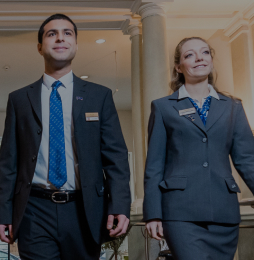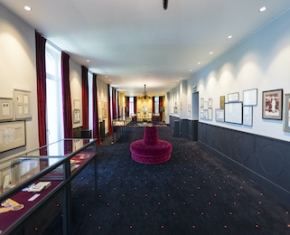- About
- Schools
- Lifelong Education
- News & Events
- Community
#Faculty
Events after COVID-19: Is it all Zoom from here?
The changes the events industry will want to hang on to
Over the past year and a half, many of us have reached a point of exhaustion when it comes to technology - we’re all sick of holding meetings with people’s foreheads or being Zoom-bombed by a partner, child, or pet. However, virtual communication and events have become an intrinsic part of our reality that we cannot do away with looking forward.
With new variants on the rise, does that mean professionals in the events industry are continuing to look at a future of organizing annual Skype conferences, Zoom-weddings, and company Christmas parties on Google Hangouts? Not likely. The reality is that we value human contact too much to take the industry 100 percent online but reverting to pre-COVID practices is also not a viable option. So, events professionals will need to do what they do best: get creative.
Keeping attendees safe
Health and safety will undoubtedly remain a key concern for the foreseeable future. Until a 100 percent successful vaccine exists and the general population is no longer at risk, event-goers will have to adjust their expectations to accommodate a few new event practices.
If you are hot, you are out! If you’re vaxxed, you are in!
Most of us are already familiar with thermal body temperature scanning which will undoubtedly become a part of the new normal at events. Whether entering a conference, concert, or birthday party, attendees can expect a quick temperature check before their welcome cocktail. Assuming they pass their thermal scan, they will still be required to social distance and, if required by their local health officials, wear masks, and event organizers will want to limit the handing out physical items that could be digitally replaced, such as programs, lanyards, or name tags.
In California, starting Sept. 20, proof of vaccination or a negative test result is now required to enter an indoor event of 1,000 or more people. In countries where vaccine roll out is proceeding more slowly, such large-size gatherings may also be prohibited.
Where is my lunchbox?
This may be the end of the beloved buffet. Buffets are typically the preferred foodservice method because they are easy to manage, provide plenty of choices, and require less staff than seated à la carte options. However, when it comes to contagions, the shared utensils can put attendees at risk. NHK Japan conducted a blacklight experiment earlier this year where 10 percent of the test subjects were “infected” before opening the buffet to all attendees. The contagion spread to 100 percent of the test subjects within 30 minutes.
Who told you!?
The eCOVID-19 contact tracing apps launched around the world have been a legal minefield. Many are confused about what exactly the apps track, which data is stored, and who has access to that data. The fear of sharing personal information is precisely why these apps have struggled to be useful. The fact remains that organizers will need to store attendee information should outbreak tracing be necessary. Luckily, events requiring registration often asked attendees to provide this necessary information before the event anyway, so there is less need to demand all event-goers download the app.
New need-to-know event tech
The events industry loves its lingo and abbreviations, so here are three new terms you might need to learn to cope with new hybrid events.
1. NFC - Near Field Communication
Have you ever used Apple or Google Pay in a store, or paid using a contactless card? If so, you have used NFC, even if you didn’t realize what it was. Embedded in all modern smartphones, NFC is an excellent tool to use as attendees will be able to use it directly on their devices. Although usually used for payments, NFC chips can easily be programmed to bring up a particular website, registration page, or show a menu. These chips, which are essentially thin stickers, can be placed around your venue, and attendees can access whatever information you want to convey to them by simply tapping their phone to the chip – no app installation necessary!
2. QR - Quick Response Code
Admittedly, QR codes, created in 1994, can hardly be classified as “new”. However, it wasn’t until much later that their use became widespread. QR codes can serve many of the same functions as NFC but without the finesse of the newer technology. When it comes to COVID-19 concerns, QR codes may be the safer option. While tapping phones onto a chip requires a certain degree of physical contact, scanning a code with your device’s camera requires absolutely none.
3. GPM - Geofencing and Proximity Marketing
Geofencing and proximity marketing are traditionally seen as two separate entities but used together they are a valuable asset to any event planner. Both technologies use push notifications through an app but differ in how and when these notifications get pushed to the user. Geofencing uses the GPS on a users’ phone to send notifications when they enter a predefined area. This is why you might get a push notification with a coupon for a coffee shop you have just walked by. Proximity marketing on the other hand uses beacons. Beacons emit a signal that sends push notifications to devices walking past. For instance, this is how your emergency medical ID is automatically displayed on your phone if you walk through the emergency entrance in a modern hospital.
How can the combination of these technologies help the events industry? The possibilities are endless: for example, while Geofencing can be used to send a notification reminding attendees to check in online as they approach the venue, beacons send key speaker profiles to their phones as they walk through the doors of conference rooms. Even though this may require more funding and tech support, the use of this kind of technology will truly leave an impact on attendees.
#Faculty





















